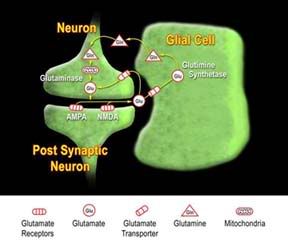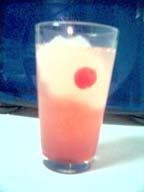Between recent research on multiple intelligences and all the controversy over Chinese food and diet soda, glutamate and its receptors are certainly a hot topic. As mentioned previously, glutamate is the most abundant excitatory neurotransmitter in the central nervous system and is also a common amino acid, readily available for the hungry brain. Glutamate has several different receptors, including the fast acting AMPA and NMDA receptors (which also binds aspartate) and the slower metabotropic receptors. NMDA stands for N-methyl d-aspartate and AMPA stands for α-amino-5-hydroxy-3-methyl-4-isoxazole propionic acid, so named for the first synthesized agonists that could produce firing in the neurons containing those receptors.
NMDA's affinity for glutamate declines with age, which may explain why grandma can be a little "slow" at times. Many drug companies are searching for ways to abate this process. There is also such a thing as "too much of a good thing," where over-stimulation of glutamate receptors can be problematic; drug companies are interested in resolving this as well. That's where today's Blue Monday interviewees come in. Chemists John Rudolph and Stephan Smith have been working on synthesis of isoxazole based ligands for use as NMDA and AMPA agonists (activators) and some for use as antagonists (blockers).

Here's John (left) and Stephan (right) looking curiously Watson and Crick as they ponder their chemistry. Working with all these excitatory receptors, John says he's certainly experienced "multiple realms of excitement." The thing that excites him most though is the fact that the ligand research is so new.
"It's something that has really stretched me," says John, "and I like that."
Aside from affecting receptors directly, another goal of theirs is to inhibit the action of excitatory amino acid transporters (EAATs). This may increase the concentration of glutamate at the synapse, similar to how MAO inhibitors work in anti-depressants. EAATs are responsible for transporting glutamate back into and out of glial cells, where it undergoes processing before it is restored to the neuron. The EAAT they're mainly interested in is called XCT, which pushes glutamate out of nearby glial cells. Neurorelief.com/ had an awesome depiction of a simplified glutamate synapse which I've included below:


The Drink!:In honor of these great chemical creations, the drink I'd like to share with you tonight is called a "Chemical Equation," but no stoichiometry is needed! Mix club soda and lemonade with a shot of vodka then add a splash of grenadine and a cherry.
Sources: Neurorelief.com/


0 Comments:
Post a Comment
<< Home